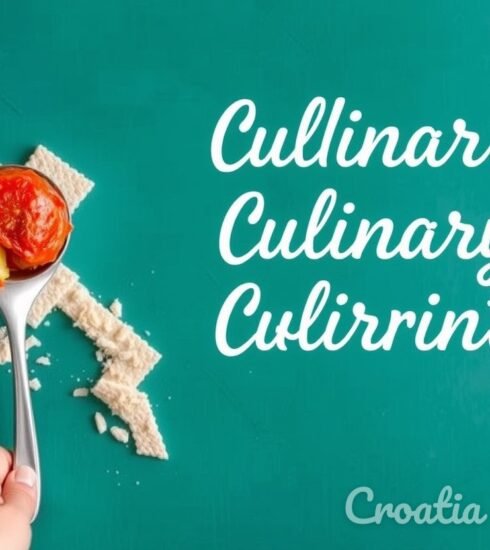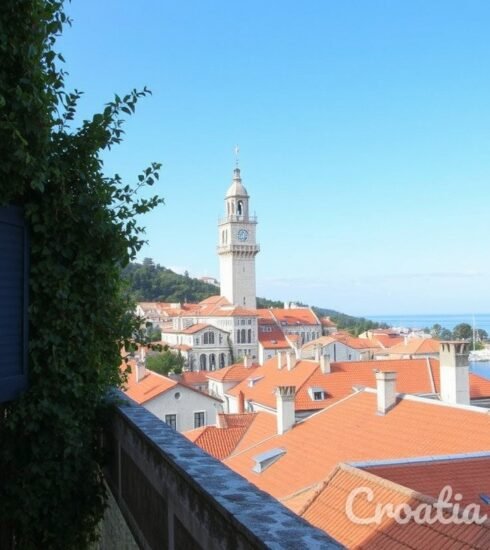Discover the Magic of Croatian Village Feasts: A Journey Through Tradition and Flavor
Tastes of Tradition: A Culinary Exploration of Croatia’s Hidden Village Feasts
The rich tapestry of Croatian culture is intricately woven with culinary traditions, especially in its idyllic villages. Here, the art of gastronomy extends far beyond mere sustenance; it is a celebration of community, history, and heritage. The phenomenon of croatian village feasts is a vivid testament to this ethos, where food serves as the focal point of social gatherings, offering a glimpse into the agrarian roots and familial traditions that define rural life in Croatia. This exploration delves into the flavors, customs, and unique dishes of these hidden village feasts, celebrating the culinary heritage that has been passed down through generations.
The Essence of Croatian Village Feasts
Village feasts in Croatia are more than just meals; they are a reflection of communal identity and cultural richness. Traditionally held in the summer months, these gatherings coincide with local festivals or saint’s days, showcasing seasonal produce and regional specialties. The importance of food in these feasts can be summarized as follows:
- Community Gathering: Bringing villagers together to strengthen bonds.
- Celebration of Local Heritage: Highlighting traditional cooking methods and recipes.
- Showcasing Seasonal Ingredients: Utilizing fresh produce unique to the region.
This integration of food with local customs creates a unique experience that allows both locals and visitors to engage with Croatian culture in an authentic way. As you wander through the quaint streets of a Croatian village, the scents of herbs, grilled meats, and baked goods entice you, inviting you to join the celebration.
The Culinary Landscape of Croatia
Croatia’s geographical diversity, from coastal regions to fertile plains and mountainous terrains, gives birth to a wide array of culinary traditions. Each region boasts its own distinctive flavors, rooted in the availability of ingredients and historical influences. Some notable regional cuisines include:
Istria
In the northern part of the Adriatic, Istria is renowned for truffles, olives, and hearty meats. Traditional dishes such as fuži (homemade pasta) served with truffle sauce and the famous Istrian pršut (cured ham) exemplify the local flavor profile. Village feasts here often feature a variety of grilled meats and fresh seafood from the nearby coast.
Dalmatia
Dalmatian cuisine is heavily influenced by its proximity to the Mediterranean. The use of olive oil, fresh vegetables, and seafood defines many classic dishes. Peka, a slow-cooked dish made of meat and vegetables under a bell-shaped lid, is a highlight during croatian village feasts, often accompanied by locally produced wine.
Slavonia
Known for its hearty fare, Slavonia’s culinary offerings include spicy sausages, rich stews, and the famous kulen, a spicy pork sausage. Village feasts here often include a multitude of dishes arranged buffet-style, allowing guests to sample various flavors unique to the region.
Key Ingredients in Croatian Village Feasts

The heart of every dish served during croatian village feasts lies in its ingredients. Local producers pride themselves on sourcing the best flavors from their surroundings, which can include:
- Olive Oil: A staple for cooking and dressing salads.
- Herbs: Fresh rosemary, thyme, and bay leaves are commonly used.
- Cheese: Regional varieties like Paški sir (sheep cheese from Pag Island) are popular.
- Meats: Lamb, pork, and poultry, often sourced locally, are integral to traditional dishes.
- Vegetables: Seasonal vegetables such as peppers, tomatoes, and zucchini are frequently featured.
These ingredients not only contribute to the flavor but also to the cultural significance of the feasts themselves, embodying the relationship between the land and its people.
Celebrating with Tradition: The Process of Preparation
The preparation of food for a village feast is a communal effort, often involving the entire village. From sourcing ingredients to cooking and serving, each person plays a role in the festivities:
Gathering Ingredients
Local farmers and producers are the backbone of Croatian village feasts. Many villagers will cultivate their own gardens for fresh produce, while others rely on farmer’s markets to obtain quality ingredients. This connection to local agriculture instills a sense of pride among villagers, fostering sustainability and community spirit.
Cooking in Unity
Cooking can often be a communal event itself. Large community kitchens or outdoor cooking spaces enable friends and families to come together, sharing stories and recipes as they prepare the feast. Understanding the traditional cooking techniques, such as cooking with wood-fired ovens or open flames, is also key to recreating authentic flavors.
- Black Pot Cooking: Utilizing cast-iron pots for slow-cooked stews.
- Grilling: Open-fire grilling gives meats a unique flavor.
- Baking Bread: Freshly baked bread, often made with wild yeast, is a staple.
Unique Dishes Served at Village Feasts
Each type of feast reflects the culinary diversity of the region. Some of the typical dishes you can expect to encounter during croatian village feasts include:
Starters

- Pršut and Cheese Platters: Cured meats and cheese served with fig jam.
- Rizi-bizi: A local risotto often made with seasonal vegetables.
- Fritule: Deep-fried dough balls, popular during festivities.
Main Dishes
- Peka: A classic dish involving meat and vegetables baked under a bell.
- Roast Lamb: Seasoned and cooked slowly, often served during special occasions.
- Fish on a Grill: Fresh fish marinated with local herbs served with a drizzle of olive oil.
Desserts
- Baklava: Layers of phyllo pastry filled with nuts and honey.
- Stari Peci: Traditional sweet bread, often flavored with citrus.
- Apple Strudel: A beloved dessert that highlights the use of local apples.
Cultural Significance of Village Feasts
Beyond food, croatian village feasts represent an opportunity to connect with cultural heritage. They are often accompanied by music, dance, and traditional attire that harken back to the local history. Here are a few aspects that illustrate their significance:
- Preservation of Traditions: Festivals serve to revive and maintain regional customs.
- Strengthening Community Bonds: Feasts foster social connections and networks within the village.
- Tourism Opportunities: Increasingly, these feasts attract tourists looking for authentic experiences.
Thus, the celebration of food during these village gatherings transcends mere enjoyment and becomes a collective memory, passed down through generations.
Events and Festivals: A Culinary Calendar
In Croatia, culinary enthusiasts can find numerous events and festivals showcasing various regional cuisines. Some notable occurrences focused on croatian village feasts include:
The Istria Olive Oil Festival
Held annually in November, this festival celebrates local olive oil producers. Visitors can engage in tastings and workshops, learning about the intricacies of olive oil production while sampling the best oils from the region.

The Feast of St. Euphemia
This festival in Rovinj celebrates the local patron saint with a week-long series of events, including traditional food fairs where community members prepare local delicacies for both locals and tourists.
Slavonian Wine Festival
In the heart of Slavonia, this festival features tastings of local wines paired with traditional dishes, showcasing the region’s viticulture alongside the rich culinary offerings.
A Modern Take on Traditional Feasts
While staying true to their roots, many village feasts have evolved to cater to contemporary tastes and trends. Chefs are increasingly experimenting with traditional ingredients, often incorporating modern cooking techniques to create a fusion of past and present. Examples include:
- Farm-to-Table: Emphasizing fresh, locally sourced ingredients.
- Plant-Based Offerings: Catering to vegetarian and vegan diets with creative dishes.
- Artisanal Products: Showcasing local producers, from cheeses to baked goods.
The result is a vibrant culinary scene that retains its authenticity while allowing for the evolution necessary to appeal to a broader audience.
Tips for Experiencing Croatian Village Feasts
For food lovers looking to immerse themselves in the experience of croatian village feasts, here are some essential tips to consider:
- Plan Ahead: Research local events, as many feasts are seasonal or tied to specific holidays.
- Engage with Locals: Don’t hesitate to ask villagers about their traditions and favorite dishes.
- Take Part: Join in the festivities—help cooking or serving if possible, to enhance your experience.
- Document Your Journey: Capture the flavors and moments through photography and journaling to remember your adventure.
Engaging with these feasts adds another layer to your travel experience, ensuring an authentic taste of Croatian culture.
Conclusion: Understanding the Heart of Croatian Culture
In the end, croatian village feasts serve as a beautiful reminder of the significance of food within community and tradition. They encapsulate the very essence of Croatian life, reflecting the land’s abundant offerings and the enduring spirit of its people. Whether you are enjoying fresh grilled fish by the Adriatic Sea, savoring hearty stews in the Slavonian countryside, or delighting in a glass of local wine under the stars, you are connecting with a culture that cherishes its roots while inviting the world to its table. From the comforting flavors of traditional recipes to the joyous celebrations that accompany them, Croatian village feasts are a culinary adventure waiting to be explored.






